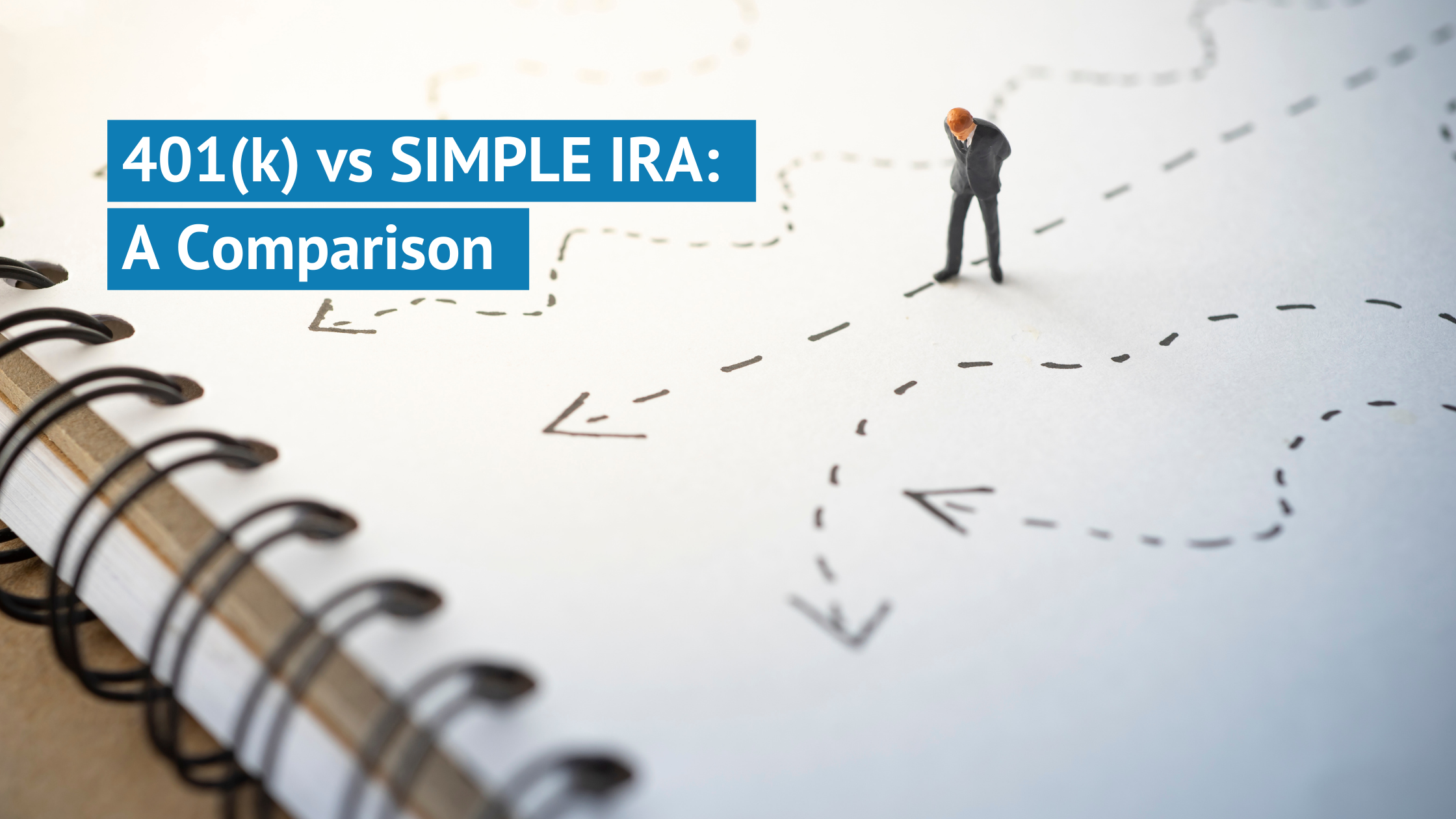401(k) vs SIMPLE IRA: A Comparison
December 1, 2021|Luke Matchett

- Choosing a retirement plan for your client is one of the most important decisions you’ll help them make
- SIMPLE IRAs and 401(k)s are two tax-deferred retirement savings options ideal for small businesses
- Small business owners may find SIMPLE (Savings Incentive Match Plan for Employees) plans more attractive due to their simplified administrative requirements and lower cost
When your task is to find a retirement savings plan for your client’s small business, that’s a huge undertaking. It’s now your job to find your clients a retirement plan that will grow with them, help both your clients and their employees save and invest for their retirement, and ensure that the plan meets their employees’ needs, their business needs, and their personal needs.
Some plans are too costly for small businesses to maintain while others are too much of an administrative burden. So how do you find the perfect plan? First, you need a really good understanding of your client’s needs and where their business is at. Second, make sure to do your research on each and every plan that’s available to them.
Here are two plans that would be great for small businesses. Both a SIMPLE IRA and a SIMPLE 401(k) are two versions of popular retirement plan options designed specifically for small businesses with up to 100 employees. SIMPLE stands for Savings Incentives Match Plan for Employees.
What’s the Difference Between a SIMPLE IRA and a Traditional IRA?
Both the SIMPLE IRA and the traditional IRA are tax-deferred retirement savings plans. The SIMPLE IRA is designed for small businesses with under 100 employees. The main difference between the two is that SIMPLE IRAs have a higher employee contribution limit ($15,500 versus $6,500) and a higher catch-up contribution limit (an additional $3,500 versus $1,000) for employees over the age of 50.
SIMPLE IRAs also require mandatory contributions from the employer. A drawback that is unlike a traditional IRA, is that SIMPLE IRAs are not permitted to have any ROTH contributions. Both SIMPLE and traditional IRAs have early withdrawal penalties of 10%, however, SIMPLE IRAs have an extra 25% penalty if the withdrawal occurs within two years of the first deposit.
How does a SIMPLE 401(k) differ from a Traditional 401(k)?
SIMPLE 401(k) plans are very similar to a traditional 401(k) with a few minor differences. The biggest difference is that the employer is required to make a contribution under a SIMPLE 401(k) plan.
These plans are designed specifically for small businesses with under 100 employees. The lack of non-discrimination testing along with straightforward benefits reduces the amount of administration required with a traditional 401(k).
Employees are immediately 100% vested in a SIMPLE 401(k). In addition, if an employee is not eligible to participate in a SIMPLE 401(k) plan, other retirement plans may be offered to them. This feature is only available under a SIMPLE 401(k) plan.
SIMPLE 401(k) vs SIMPLE IRA: What’s the Difference?
| SIMPLE 401(k) | SIMPLE IRA | |
| Employee Contributions | Up to $15,500 annually | Up to $15,500 annually |
| Annual Compensation Limit | All contributions may not consider compensation beyond a cap of $330,000 (indexed) | Non-elective contributions may not consider compensation beyond a cap of $330,000 (indexed) |
| Catch-Up Contributions | $3,500 annually | $3,500 annually |
| Eligibility Requirements | Must be 21 years of age and have received at least $5,000 in any 2 years before the current calendar year and expect to receive at least $5,000 in the current calendar year | Must have received at least $5,000 in any 2 years before the current calendar year and expect to receive at least $5,000 in the current calendar year |
| Loan Provisions | Yes | Not available |
| Vesting | Immediately 100% | Immediately 100% |
| When to Start One | Plans can be established on any date between January 1st and October 1st | Plans can be established on any date between January 1st and October 1st |
| Administration | No non-discrimination testing Annual Form 5500 filing | No non-discrimination testing |
| Other Plans | Available for employees who are ineligible for any other 401(k) offered by the employer | Not available |
| Early Withdrawal Penalties | 10% before age 59.5 | 10% before age 59.5 Additional 20% if the withdrawal occurs within the first 2 years of the first contribution |
The main benefit of a SIMPLE 401(k) compared to a SIMPLE IRA is the added flexibility associated with the plan. The ability to take out a loan is very beneficial for employees who may need to access their assets, but are not yet fully eligible to withdraw from their account without penalties. Another benefit of the SIMPLE 401(k) is the ability to sponsor other plans for employees who are not eligible for a SIMPLE 401(k).
One drawback of a SIMPLE 401(k) in comparison to a SIMPLE IRA is the annual required form 5500 filing. The annual filing, along with keeping track of additional plans sponsored for non-eligible employees, can add strain on the administration. However, this is the tradeoff for a more flexible retirement savings plan.
Traditional 401(k) compared to a SIMPLE IRA
| Traditional 401(k) | SIMPLE IRA | |
| Employee Contributions | Up to $22,500 ($20,500 for 2022) | Up to $15,500 ($14,000 for 2022) |
| Employer Contributions | $66,000 ($61,000 in 2022) per person less employee deferrals (exclusive of catch-up contributions) | 3% of payroll |
| Catch-Up Contributions | $7,500 annually | $3,500 annually |
| Eligibility Requirements | May exclude those under 21 years of age and one year of service | Must have received at least $5,000 in any 2 years before the current calendar year and expect to receive at least $5,000 in the current calendar year |
| Loan Provisions | Yes | Not available |
| Vesting | Immediately 100% on Employee Contributions Employer Contributions may be vested for up to 6 years | Immediately 100% |
| When to Start One | Plans can be established before the plan’s year-end | Plans can be established on any date between January 1st and October 1st |
| Administration | Non-discrimination testing Annual Form 5500 filing | No non-discrimination testing |
| Other Plans | Available but must comply with overall IRS limits by combining all deferrals | Not available |
| Early Withdrawal Penalties | 10% before age 59.5 | 10% before age 59.5 Additional 25% if the withdrawal occurs within the first 2 years of the first contribution |
Much like a SIMPLE 401(k), a traditional 401(k) offers even more flexibility in comparison to a SIMPLE IRA. The wide range of investment options allows you to customize their plans even more in order to meet your client’s needs.
Another key difference is the ability of the employee to make Roth contributions with a traditional 401(k). This added flexibility comes with more administration requirements including non-discrimination testing. If your client has a small business with fewer than 100 employees, a traditional 401(k) may not be worth the added administrative work. If that is the case, then a SIMPLE IRA may be the best retirement plan option that allows employees to defer income with limited administration.
Interested in comparing other plans? Check out how a Roth IRA compares to a Roth 401(k) here.
Bottom Line
Both SIMPLE 401(k)s and SIMPLE IRAs are solid retirement plan options for small business owners. What it ultimately comes down to is your client and their needs. Think about the participant’s ability to take out a loan against their funds, the withdrawal penalties, and eligibility requirements. In order to make the best decision for your client, their company, and their employees make sure to do ample research on each plan’s limits, requirements, and regulations.
Finding and managing a retirement plan is no small undertaking. It may be worthwhile to partner with a retirement plan third-party administrator who can custom design the optimal retirement plan for your clients and handle the day-to-day plan administration and compliance.
If you want our team to design and manage your clients’ retirement plans, fill out your info here.

About The Author Luke graduated from the University of Connecticut with a B.A. in Actuarial Science. He brings a strong mathematical and analytical background to his role as a Consulting Actuary at Odyssey Advisors. He designs and maintains complex client-employee benefit programs...
More Insights From This author

April 6, 2023
Luke Matchett





